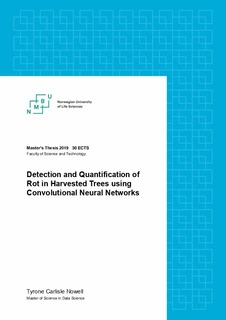| dc.contributor.advisor | Liland, Kristian Hovde | |
| dc.contributor.advisor | Tomic, Oliver | |
| dc.contributor.author | Nowell, Tyrone Carlisle | |
| dc.date.accessioned | 2019-10-08T13:27:18Z | |
| dc.date.available | 2019-10-08T13:27:18Z | |
| dc.date.issued | 2019 | |
| dc.identifier.uri | http://hdl.handle.net/11250/2620961 | |
| dc.description.abstract | Root and Butt-Rot (RBR) is having a significant economic impact on the forest
industry and is expected to increase with climate change. The current management
strategies are becoming less effective, and little data on RBR distribution is available
to develop new ones. In Europe, approximately half of the timber production is
using Cut-To-Length timber harvesters which store a considerable amount of data
on each tree. Being able to supplement this data with the presence and quantity of
RBR in the tree would add significant value to both the forest industry and to the
scientific community in developing new strategies for RBR management.
This Master’s thesis explored the feasibility of embedding a computer vision system
on the harvester for autonomous rot detection and quantification using state
of the art Convolutional Neural Networks (CNNs). Among the potential applications
of this system, this study assessed the possibilities to (1) provide real time
feedback of this information to the harvester operator for faster, more accurate categorisation
of the timber quality and (2) enable the collection of big data on RBR
distribution for high spatial resolution mapping for the development of new management
strategies.
The model developed to detect RBR achieved an F1 score of 97.1% accuracy (precision
of 95.2% and recall of 99.0%) which is a significant improvement over previous
techniques with an F1 score of 90.8% accuracy (precision of 90.8% and recall
of 90.8%). Prediction of the RBR quantity as a percentage of the surface area attained
an RMSE of 6.88%, and was reduced to 6.17% when aggregated with the
RBR detector.
Evaluating the misclassifications of the detection system indicated that the model
performance is at least on par with that of the author. These results indicate that
there is significant potential in developing this technology further for both economic
and environmental gains. | nb_NO |
| dc.language.iso | eng | nb_NO |
| dc.publisher | Norwegian University of Life Sciences, Ås | nb_NO |
| dc.rights | Attribution-NonCommercial-NoDerivatives 4.0 Internasjonal | * |
| dc.rights.uri | http://creativecommons.org/licenses/by-nc-nd/4.0/deed.no | * |
| dc.subject | Machine Learning | nb_NO |
| dc.subject | Deep Learning | nb_NO |
| dc.subject | Forestry | nb_NO |
| dc.title | Detection and quantification of rot in harvested trees using convolutional neural networks | nb_NO |
| dc.type | Master thesis | nb_NO |
| dc.description.version | submittedVersion | nb_NO |
| dc.subject.nsi | VDP::Technology: 500 | nb_NO |
| dc.source.pagenumber | 105 | nb_NO |
| dc.description.localcode | M-DV | nb_NO |

